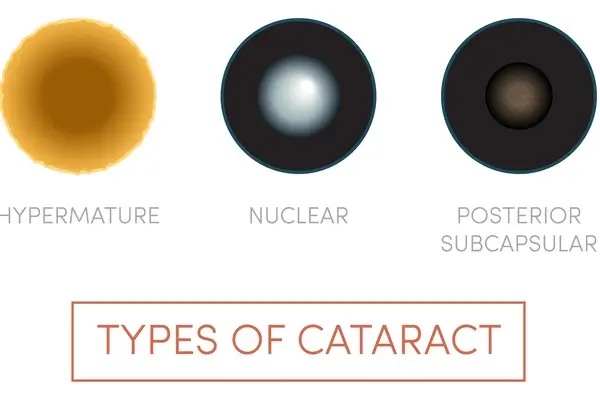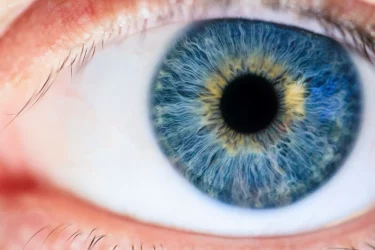Understanding the different types of cataracts is crucial for early detection, proper diagnosis, and appropriate treatment. In this blog, we delve into the various types of cataracts and what sets them apart.

Cataract types, symptoms, and causes
Understanding the type of cataract you may have is vital for devising an appropriate treatment plan. Regular eye examinations and consultations with your optometrist can help detect cataracts early. Your optometrist can also guide you towards the most suitable course of action.
Nuclear cataracts
Nuclear cataracts are the most common type and primarily affect the centre of the lens (called the nucleus). These cataracts usually develop with age. They form deep in the central part of the lens and increase gradually, causing the centre of the lens to become yellow or brown. As the cataract progresses, it can significantly impact both near and distance vision. Nuclear cataracts can change the power of the natural lens in the eye, meaning you may notice your glasses prescription changing more frequently.
Causes and risk factors
The most common cause is the natural ageing process. As you get older, the proteins within the eye’s lens can break down and clump together. This causes the lens to become cloudy and yellow.
Diabetes, genetics, and smoking are risk factors for several cataract types.
Symptoms
- blurring or dimming of vision
- glare
- visual distortion
- increasing short-sightedness/decreasing long-sightedness.
Progression
Progression can vary from person-to-person depending on various factors. These include genetics, overall eye health, and general lifestyle.
Treatment
The primary and most effective treatment for nuclear cataracts is cataract surgery. This surgical procedure is highly successful in restoring clear vision and is one of the most commonly performed surgeries worldwide.
Cortical cataracts
Cortical cataracts develop on the lens cortex which is the outer edge of the lens. They often start as whitish, wedge-like opacities that progress inward. This type of cataract may also cause halos around lights. This type of cataract begins at the edge of the lens and can be described as gradually moving into the centre in a spoke-like manner.
Causes and risks
Cortical cataracts can be caused by increased risk factors such as diabetes, ageing, and genetics.
Symptoms
- glare
- difficulty with contrast and colour perception
- blurred vision
- problems with night vision.
Progression
Cortical cataracts can develop quite quickly, usually over a period of a few months.
Treatment
The primary and most effective treatment is cataract surgery. This surgical procedure is highly successful in restoring clear vision and is one of the most commonly performed surgeries worldwide.
Posterior subcapsular cataracts
Posterior subcapsular cataracts occur at the back of the lens, just beneath the lens capsule.
Causes and risk factors
Posterior subcapsular cataracts can be caused by taking steroid medication on a long-term basis, diabetes, exposure to radiation, or extreme near-sightedness.
Symptoms
- blurred vision
- difficulty with vision in bright light
- difficulty reading and driving, especially at night
- halos or glare around lights.
Progression
Posterior subcapsular cataracts can progress faster than other types, however, this varies widely. This type of cataract can be asymptomatic so it’s important to get regular eye health checks.
Treatment
The most effective treatment is cataract removal surgery. This surgical procedure is highly successful in restoring clear vision and is one of the most commonly performed surgeries worldwide.
Congenital cataracts
Congenital cataracts are present at birth or develop during early childhood. Early diagnosis and treatment are crucial to preventing visual impairment in children.
Causes and risk factors
They may be hereditary, caused by infections, or metabolic problems during pregnancy.
Symptoms
- cloudy or hazy pupil
- abnormal eye movements
- poor vision
- sensitivity to light
- difficulty maintaining eye contact.
Progression
The progression rate can be highly variable.
Treatment
The treatment of congenital cataracts typically involves surgical intervention. In some cases, additional therapies are recommended to support visual development and rehabilitation.
Early detection and intervention is important to improve visual outcomes and overall eye health in children.
Traumatic cataracts
As the name suggests, traumatic cataracts result from an eye injury. The lens can become clouded either immediately after the injury or a number of years later.
Causes and risk factors
This type is caused by injury to the eye.
Symptoms
- blurred vision
- visual distortions such as glare around bright lights
- eye pain or discomfort
- swelling and / or redness
- light sensitivity.
Progression
The progression of traumatic cataracts can vary significantly depending on the nature and severity of the eye injury.
Treatment
The treatment for traumatic cataracts typically involves cataract surgery. During this procedure, the affected lens is removed and, if suitable, replaced with an artificial cataract lens.
Secondary cataracts
Secondary cataracts can develop after surgery for other eye conditions, such as glaucoma or retinal disease. This type of cataract occurs when lens cells that were not removed during the initial surgery begin to cloud over time.
Causes and risk factors
Secondary cataracts can develop after surgery for other eye conditions, such as glaucoma or retinal disease.
Symptoms
- blurred vision
- difficulty seeing fine details
- glares and halos
- changes in colour perception
- light sensitivity.
Progression
The progression of secondary cataracts is gradual. The timing can vary among individuals. It may take between months to several years for symptoms to become significant or even noticeable.
Treatment
A quick and painless laser procedure called YAG laser capsulotomy is typically used to correct secondary cataracts. YAG laser capsulotomy involves using a laser to create a small hole in the posterior capsule of the lens. This aims to improve vision if clouding occurs after surgery.
However, the most effective treatment for secondary cataracts is surgery. This surgical procedure is highly successful in restoring clear vision and is one of the most commonly performed surgeries worldwide.
Radiation cataracts
Radiation cataracts are a specific type that develop as a result of exposure to ionising radiation.
Causes and risk factors
Exposure to ionising radiation during medical procedures (such as radiation therapy for cancer treatment) or from working in nuclear plants (if protection measures are not taken) can cause radiation cataracts.
Symptoms
Symptoms are the same as most types of cataract symptoms.
Progression
Radiation cataracts typically progress slowly over time. The rate of progression is influenced by factors such as the dose and duration of radiation exposure and individual susceptibility.
Treatment
The primary treatment is cataract surgery. This surgical procedure is highly successful in restoring clear vision and is one of the most commonly performed surgeries worldwide.
Types of cataract surgery
Cataract surgery is a common and highly effective procedure. It is designed to improve vision by removing cloudy lenses from the eyes and replacing them with clear artificial lenses. These are known as intraocular lenses (IOLs). Over the years, several surgical techniques have evolved to address varying degrees of cataract development and individual patient needs.
Phaco-emulsification is the most common and advanced cataract surgery technique. During this procedure, a small incision is made in the eye. A tiny probe is then inserted to break up the cloudy lens using ultrasound energy. The lens pieces are then suctioned out, and the IOL is placed in the lens capsule.
Why choose Practice Plus Group?
Understanding the type of cataract you may have is vital for devising an appropriate treatment plan. Regular eye examinations and consultations with an optometrist can help detect cataracts early and guide you towards the most suitable course of action.
If you suspect you may have cataracts or are experiencing changes in your vision, it’s essential to consult an eye care professional promptly. Early intervention and appropriate management can help preserve your vision and improve your quality of life.
Cataract types FAQs
Not quite found what you’re looking for? Our dedicated cataract types FAQs might be able to help!
Yes. They are typically classified based on their location and how they develop within the eye.
There are three main types of cataracts:
- nuclear
- cortical
- posterior subcapsular.
Yes. While cataracts, in general, cause a gradual clouding of the eye’s natural lens, different types of cataracts can lead to varying visual disturbances and discomfort. See the differing symptoms above.
The most common type of cataract is nuclear sclerotic cataract. This type is primarily associated with the ageing process and is often referred to as an age-related cataract.
The following types of cataracts are not necessarily rare but occur much less frequently than age-related cataracts:
- congenital cataracts
- traumatic cataracts
- posterior polar cataracts
- anterior polar cataracts
- cerulean cataracts.
The term “aggressive” is not typically used to describe cataracts. The speed at which cataracts develop and the impact on vision differs from patient-to-patient. They are not classified as “aggressive” like other diseases.
While some types of cataracts may progress quicker than others, they are usually managed through cataract surgery when they significantly affect vision.
The difficulty of removing a cataract is not primarily determined by the cataract type itself but by various factors. These include:
- the cataract’s characteristics – if a cataract is left to develop, the surgery will be more challenging
- the patient’s eye characteristics – if an eye is structurally small or the pupils do not dilate well, this can increase the difficulty of the surgery.
While some cataract types (like posterior polar cataracts) can be more challenging due to their location, modern surgical techniques have made cataract surgery successful in most cases. A skilled surgeon will assess all these factors to ensure the best approach.
The type of cataract that is most commonly associated with ageing is called a nuclear cataract. These cataracts are primarily caused by the natural ageing process and are characterised by the gradual clouding or yellowing of the centre of the lens. As a result, people with nuclear cataracts typically experience a slow and progressive reduction in distance vision as they age. These cataracts are one of the most common types and are often found in older individuals.






